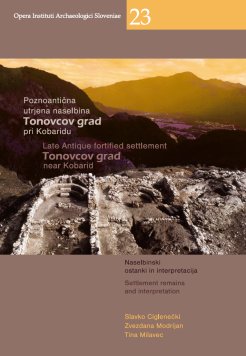 Institute of Archaeology Institute of Archaeology |
[Slovenian] |
| Home | Members | Programme | Projects | Laboratory |
| Database | Publications | Library | Links | Archive |
This book presents the results of field investigations at Late Antique hilltop settlement Tonovcov grad near Kobarid, belonging to the best preserved Late Antique settlements in Slovenia and boarder eastern Alpine area. At first, the position of the settlement and its present-day appearance were presented, then the archaeological picture of the Soča River valley and the road network in Late Antiquity. Investigations, going on from 1993 to 2005, reveals the remains of three early Christian churches, some dwelling houses and a water cistern. The book presents the stratigraphic situation and the settlement phases in all excavation fields (building 1, buildings 2 and 3, ecclesiastical complex, water cistern) as well as their dating. The first prosperity of the Late Antique settlement started in the middle of the 4th cent. and lasted to the first decades of the 5th cent. Due to the strong building activities at the beginning of the 6th cent., the buildings of the first phase were poorly preserved, however rich small finds were found. The life in the settlement reaches its peak in the beginning of the 6th cent. At this point of time, new dwelling houses and an ecclesiastical complex of three connected churches were built. The quality of the preservation of the churches enabled a boarder study of early Christian architecture in the eastern Alpine and Adriatic area. Settlement is placed in the boarder framework of the western Slovenia and Friuli in the Late Antiquity. In the second half of the 4th cent. it represented an important part of the Late Roman defence system of Italy and in the 6th century a religious and administrative centre of the autochthonous inhabitants in the Soča River valley. The last zenith of the settlement dated in the middle of the 6th cent., when it played an important role in consolidation of the byzantine authority after the byzantine-gothic war. The decline of the settlement dated in the beginning of the 7th cent. *** 2011, (Opera Instituti Archaeologici Sloveniae, 23), 304 pages, 211 b-w and colour photos, drawings and charts, 5 inserts, 20 x 29 cm, hardcover, ISBN 978-961-254-331-0. |

